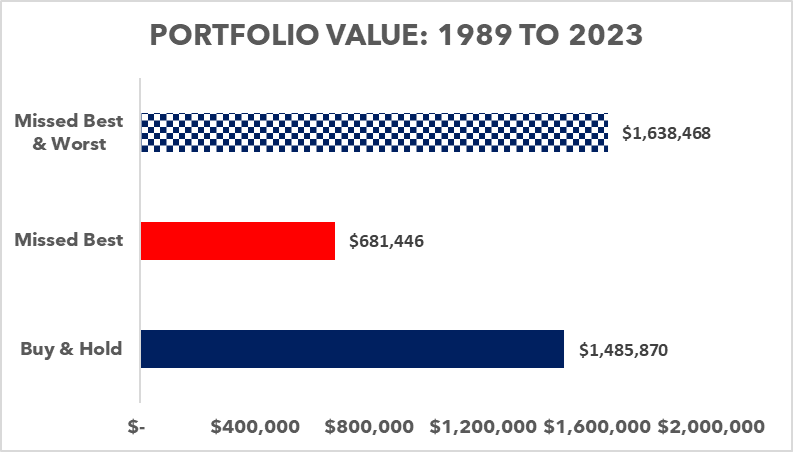
The Portfolio Impact of Missing the 10 Best and the 10 Worst Days In the Stock Market
From 1989 to May of 2023, how would an investor have fared if they missed both the 10 best and the 10 worst days in the stock market, as represented by the S&P 500? They would have $153,000 more dollars than a buy and hold investor.

Source: Mulholland & Kuperstock Asset Management
There are 900-million Google results for the query of “stock market missed 10 best days.”

We couldn’t find one result that quantified the more balanced question of what if you missed the 10 best AND the 10 worst. So, we crunched the numbers.
Every financial services firm you can think of, from Wells Fargo to Motley Fool, has some iteration of this “missed 10 best” graph to demonstrate the folly of trying to time the market. By removing only the 10 best days they show that an investor would have half the amount of money as a buy and hold investor, as the Google summary above helpfully details.

Source: Mulholland & Kuperstock Asset Management
The good intentions of the “ten best days” exercise is to encourage investors not to act on their emotions and move their money out of the market after a severe drawdown, because they will miss big positive returns as the market recovers. Indeed, the best and worst days happen side by side during stressful market periods. In fact, 100% of the ten best days (on the left in the table below) in the stock market’s modern history all occurred in the Great Financial Crisis of 2008 and the Covid crash of 2020. The worst days also occurred during financial crises (on the right side in the table).

Source: Mulholland & Kuperstock Asset Management
The “10 best” articles seem to imply that you do not want to forsake these returns as it reduces your portfolio size. But, in both 2008 and 2020, despite experiencing the 10 best days in modern stock market history, investors were still in the red. The damage done from the bad days dominated the subsequent rallies.
We don’t like the financial media shaming the investor public into thinking the best they can do is get on the stock market rollercoaster and hold on for dear life.
A fuller examination of the evidence is suggestive that avoiding the extremely volatile periods of the market is better for clients’ financial and emotional health than simply buying and holding.
